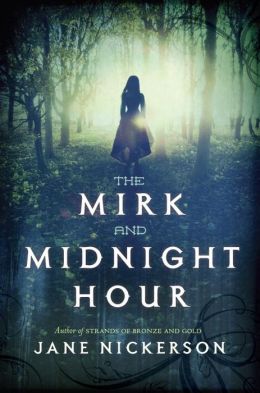The Mirk and Midnight Hour, by Jane Nickerson
Mar 24
2014

When I saw the press notes for Jane Nickerson's The Mirk and Midnight Hour, which describe the book as a "haunting love story and suspenseful thriller" inspired by the Tam Lin fairytale, I applauded the author's ambition. She was taking a risk: Tam Lin doesn't have the universal appeal of, say, Cinderella, plus there are already two extremely well-regarded YA versions out there (Pamela Dean's Tam Lin and Diana Wynne Jones's Fire and Hemlock). But once I started reading, I realized that while there are elements of Tam Lin scattered throughout Ms. Nickerson's story, she seems to have been even more, er, directly inspired by Mary Stewart's 1958 novel Nine Coaches Waiting.
Nickerson's heroine is seventeen-year-old Violet Dancey, who is still mourning the death of her twin brother when her father decides to enlist in the Confederate army. Before he leaves, Violet's father accepts the guardianship of his orphaned nephew and remarries, providing his daughter with a laudanum-swilling stepmother and selfish, flighty stepsister. Nervous but resourceful, Violet is left to care for her newfound family members as best she can, but her efforts are complicated by the ongoing war, the presence of a mysterious doctor and his voodoo-practicing African companions, and the wounded Union soldier she discovers in the woods.
I want to do justice to The Mirk and Midnight Hour. Nickerson's writing is easy and evocative, she creates several vivid supporting characters, and she does her best to present a slave-owning protagonist with nuance and grace. (Violet is conflicted about slavery, for what little it's worth.) But none of this mattered to me, because every time I attempted to immerse myself in the story, a fresh reminder of Nine Coaches Waiting would pop out of the woodwork. Behold the most striking similarities (obviously, spoilers for both books ahead):
From Nine Coaches Waiting, chapter 11:
Review based on publisher-provided copy.
Nickerson's heroine is seventeen-year-old Violet Dancey, who is still mourning the death of her twin brother when her father decides to enlist in the Confederate army. Before he leaves, Violet's father accepts the guardianship of his orphaned nephew and remarries, providing his daughter with a laudanum-swilling stepmother and selfish, flighty stepsister. Nervous but resourceful, Violet is left to care for her newfound family members as best she can, but her efforts are complicated by the ongoing war, the presence of a mysterious doctor and his voodoo-practicing African companions, and the wounded Union soldier she discovers in the woods.
I want to do justice to The Mirk and Midnight Hour. Nickerson's writing is easy and evocative, she creates several vivid supporting characters, and she does her best to present a slave-owning protagonist with nuance and grace. (Violet is conflicted about slavery, for what little it's worth.) But none of this mattered to me, because every time I attempted to immerse myself in the story, a fresh reminder of Nine Coaches Waiting would pop out of the woodwork. Behold the most striking similarities (obviously, spoilers for both books ahead):
1. Both stories hinge upon a young boy inheriting a large estate.The biggest difference is that in Stewart's novel there are two suspicious relatives (one is the villain; the other the heroine's love interest), while Nickerson's handsome soldier is wholly unconnected to the poisoning storyline—but even his interactions with Violet owe something to Nine Coaches Waiting. Check out these two scenes, both of which feature the heroine trying, inarticulately, to make her feelings known.
2. The boy has an older relative who had previously been heir to the estate. When the boy's parents die, the relative plots to kill the boy and recover his inheritance.
3. The relative's early attempts to murder the boy are meant to seem like accidents (a fall, a stray bullet), but when he grows desperate the boy is given a poisoned hot drink.
From Nine Coaches Waiting, chapter 11:
“Raoul,” I said suddenly, urgently.Aaaand this is from The Mirk and Midnight Hour, chapter 30:
“Yes?”
“Oh... nothing.”
“Just Raoul?”
“Yes.”
He slanted a look down at me and smiled. “Soit,” was all he said, but I had the odd feeling that he understood.
“Thomas,” I said urgently.See? These uncredited “tributes” left a bad taste in my mouth, which sucks, because there is nothing technically illegal about writing stories inspired by other stories. (Just ask E.L. James.) If only Nickerson had acknowledged the Stewart inspiration, I'd probably be applauding her decision to update one of the most entertaining romantic thrillers of the 20th century, no matter how flawed the result. As it is, all I can appreciate is her really great taste—I still think her behavior was shady as hell, but, hey, at least she "borrowed" from the best...?
“Yes?”
“Oh... nothing.”
“Just 'Thomas.'”
“Yes.”
He smiled, but in a wistful sort of way, and I knew he understood.
Review based on publisher-provided copy.
Posted by: Julianka
No new comments are allowed on this post.
Comments
Sasha
HELLOOOOOOOOOOO